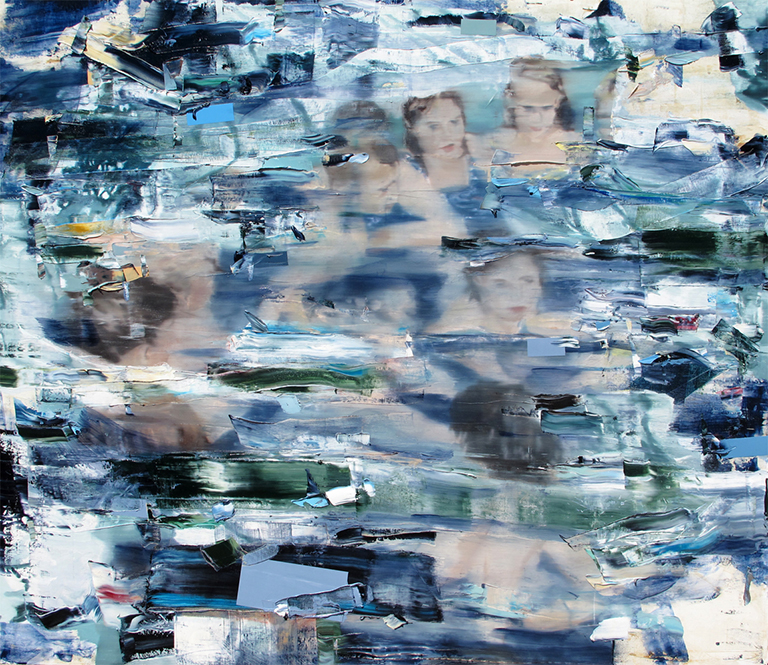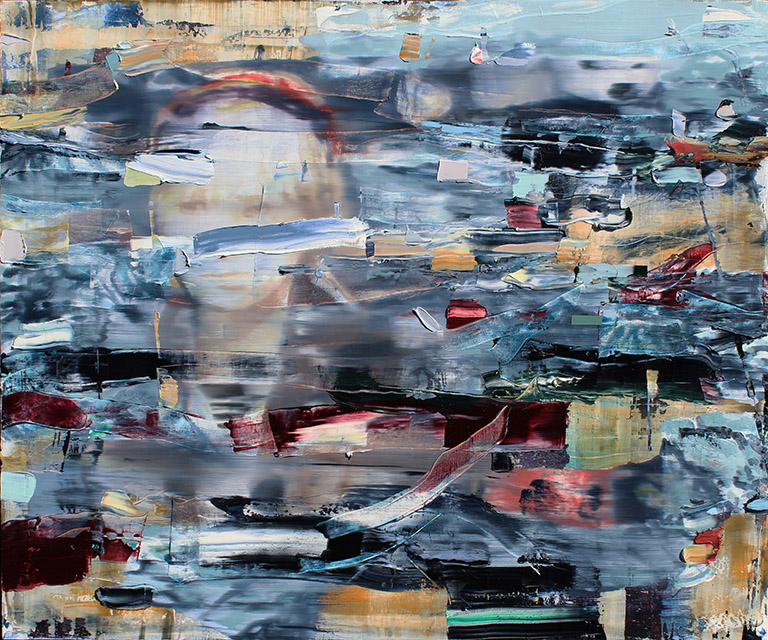by Jonathan Curiel
Ian Kimmerly | Water Logic, 2012 | Oil and acrylic on canvas | 60 x 68 in.
It was Renoir who said that a work of art "must seize upon you, wrap you up in itself, and carry you away." Interviews with artists should have a similar effect. With "Artist's Statement," our weekly interview series with prominent and upcoming visual artists in San Francisco, SF Weekly speaks to the people behind the art you see in the galleries, in the museums, and in the streets.
Ian Kimmerly is that rare painter, and his hybrid work is on display at Dolby Chadwick Gallery (210 Post Street) through July 6. Kimmerly, 33, who has exhibited around the United States, spoke to SF Weekly about finding inspiration in old magazines, living the artist's life in London, and how his art made the cover of an obscure academic book about property and democracy.
Q: The title of your new exhibit, Continuous Wave, evokes all sorts of things, including surfing. Are you a surf-riding painter?
A: I came across the phrase, "Continuous Wave," looking through a book of old media technologies and their influence on the cultures of the time. And there was this bit about early radio and some form of radio called continuous wave radio. I liked the sound of that. And I had that in a journal for a couple of years, and when I was putting the show together, I found it again -- and it worked with the subject matter, the paintings, and the notion of something that's connecting all the paintings together. When you're in the show, there's this movement -- this left-right motion that is happening. I was thinking of waves that way. And there's also water in some of the paintings. And, to tack on top of that, there's this continuous flow of information that we have to come to terms with in the digital age that we live in -- a continuous wave of Facebook posts, and pictures, and all that. I thought it was perfect enough; it had space to take on the multitude of meanings that the work deal with. Each painting isn't about one particular idea, per se.
Q: I love your work called Water Logic. I read that it was partly inspired by an old National Geographic magazine. Do you regularly go through old National Geographics for inspiration?
A: I did a series of paintings before this group of work that were all based on specific images that I took from old video from my childhood, and those were so cut and dry -- the source of the painting becomes the painting -- and so I really wanted to start collecting a bunch of images that I didn't have a personnel connection to. I found it really freeing. I went to a couple of estate sales and found the French equivalent of National Geographic. I was really interested in the colors of the images, and the advertisements, as well as the images themselves. I was collecting lots of bits of things. I'd have 5 or 6 images in a pile that I thought could go into a painting. So I like a couple of figurative images, but I was basing the painting on a whole different set of colors. So maybe there was an image in that pile that I wanted to base the colors on that wasn't the figurative pictures I found. You have to step back and cherry-pick a bunch of images.
Ian Kimmerly | Stay Awhile My Inner Child, 2012 | Oil and acrylic on canvas | 60 x 72 in.
Q: There seem to be people bathing in Water Logic. Is the work a statement about bathing?
A: I had this original image of people in a hot spring. I was really interested in the way that you could see part of the legs and part of the bodies of people were under water, and some were on top of water. So there was this kind of blueish, greenish, purple thing that was happening with the water. A limb, when it's submerged in water, becomes a little purple. So I was really interested in that idea of semi-submerged figures and kids. And I thought it worked with the idea of how much kids have to navigate right now with all the digital media out there. With the painting of it, I started doing some thin layers of color to get the watery effect, and then it took on the full palette of cool purples and pale colors.
Q: At 33, you're almost a kid yourself. Do you try to avoid too much digital media?
A: I dip in and out of it. I think it can become a compulsion really quickly. You can go from using it as a tool and using it as something that enriches your life and your connections with people, to semi-addictive. I was just reading this book by Nicholas Carr, The Shallows, about how email can become like a slot machine for people. You get a good email every once in a while, and so you're always checking your email, and kind of pulling the lever to see if you can get the three cherries to line up. Neurologically, that's what's in the background. I think it's important to pull back and be a little self-critical.
Q: Was there ever a "eureka" moment where you realized you wanted to combine figurative work with abstraction on the same canvas?
A: I don't think about my paintings in those terms as much as I think about what I want the content to be. Big picture, I'm always very interested in the urban experience vs. the natural world, and the conflicts there. I find that the best way to get at that is to have some kind of figuration. I represent day-to-day experience, and what better way to represent that than with a human figure? And then abstraction -- I think about it more as having the experience of the painting. I don't really think of it as combining abstraction and representational images. I think about the whole thing as one piece -- kind of the gestalt effect. It's important to, up close, enjoy some of the paint and the materials happening, but also to step back and see the movement. I've always been interested in the Bay Area expressionist paintings, the figurative paintings, of Elmer Bischoff and Diebenkorn, and the whole figure-drawing relationship. There are figures, but they're also dealing with space in a really interesting way with blocks of color to define the levels of space, and the material quality of the paint. Is it light from a window, or is it just a blob of paint? Is it acting as an image or is acting as material?
Ian Kimmerly | The Living Layer, 2013 | Oil and acrylic on canvas | 40 x 48 in.
Q: I haven't met too many artists who've attended the London School of Economics. How did the academic environment there fuel your interest in art?
A: I was there for a summer semester, while I attended the University of Michigan. I had one economics prerequisite to fulfill for my degree, and I also took a theater-criticism class on British theater and contemporary theater, and a film-criticism class on contemporary cinema. I wrote a paper on Trainspotting, and read the screenplay for that. And then I went to the White Cube and the Tate Modern, and really just had a contemporary art smorgasbord in London. For me, that experience was about getting plugged in to contemporary art in a major art center, and getting to meet lots of filmmakers and seeing some plays and really experiencing how all those different disciplines can connect and diverge as well. That's one of the things I like about living in San Francisco -- that you can see some of these things in the flesh. It's important for everyone -- artists especially -- to see work like the Mark Bradford show at SFMOMA not too long ago. Looking at that work, and seeing a room full of it, is a completely different experience. There's lot to learn just from the textile qualities of work like that.
Q: You got your MFA from the University of Arizona. Why did you move to San Francisco?
A: I met my wife in Arizona. It sounds like a country song or something. She was in the creative writing program, and I was in the art department. We wanted to move somewhere together, and we decided San Francisco was a livable city and a good size, and had pretty easy access to nature and hiking. It just seemed like a good fit for us. That was over six years ago. When we got here, we went through the whole experience of going to apartment openings and all that. The good and bad of the Bay Area. It was as advertised.

Q: Your artwork appears on the cover of an obscure academic book called Property-Owning Democracy. How did it get there?
A: Several years ago, I had a friend who knew someone who worked at the publisher of that book, so they always had my website in their list of things to look at for covers and whatever it might be. And the writers of that book saw my work and thought that particular painting would work for their cover because of the combination of urban landscape with the black-and-white houses and the figures drifting above back and forth. The issues of finding a fair economic system and fair housing for people was represented in that image, I guess.
Q: What's the title of that painting?
A: It's actually untitled. I just couldn't think of a title for it. I think it's the only untitled work I ever made. (Laughs.) I'm usually more opinionated about what the work is going to be called. I made that in 2006. It's based more off a collage. The idea is one thing. How you can communicate it is where the fun and difficult work comes in. For me, that painting back in 2006 was more flat and more dedicated to the image and conveying the image. And now I'm much more interested in some of the happy accidents that happen with adding large chunks of paint and scraping them away and really trying to give the material a voice and really work with the specific things that paint can do -- how it can function. Because it's an important question to ask yourself: Why am I working in this medium? What is it about paint on canvas? It's such a traditional thing. It's been done for centuries. So for me, I've always been attracted to paint because it calls up the history of art, but also because -- gosh -- there are still so many options and possibilities with it. It's kind of a monomaniacal pursuit -- a crazy obsession.



